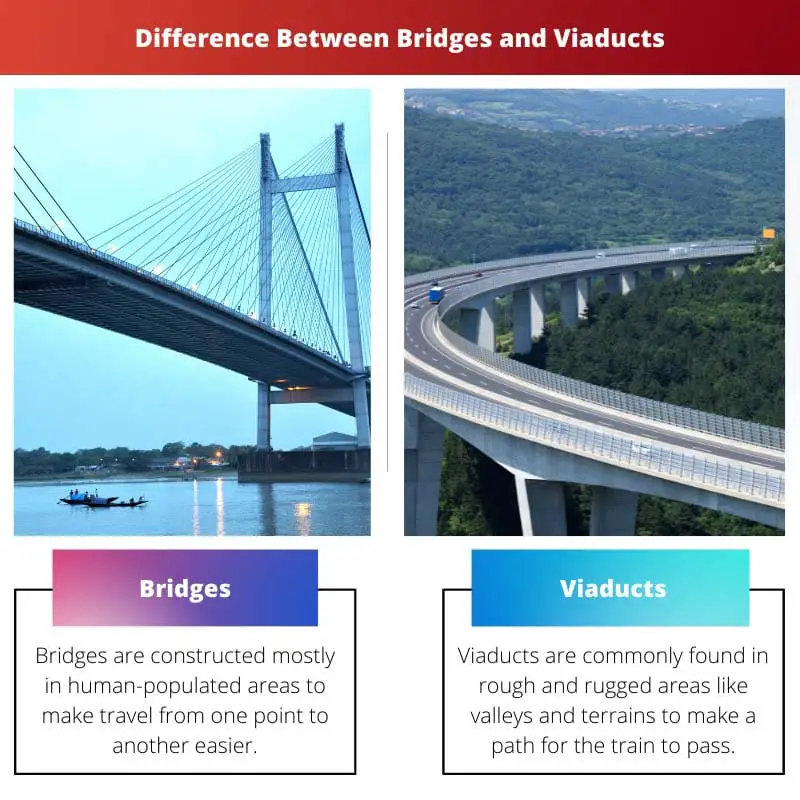Bridges might seem to be an ordinary structure, but it has a vital role to play. Bridges are a very important part of transportation.
They can be found everywhere whether it’s a city, village, plains, plateau, hills, valleys, rivers, etc. The designs of bridges have been constantly modified by the passing of time.
Key Takeaways
- Bridges span various obstacles, such as water bodies, valleys, or roads, and can be designed for pedestrians, vehicles, or trains.
- Viaducts are bridges characterized by multiple arches and piers and are commonly used for railways and highways.
- Both structures provide efficient transportation solutions, reducing travel time and enhancing location connectivity.
Bridges vs Viaducts
A bridge is a structure that spans a gap, is used for shorter spans, and can be made of various materials such as concrete. A viaduct is a long bridge that consists of multiple spans supported by arches or columns, is used for longer spans, and tends to be more massive and complex than bridges.

A structure that has been constructed to carry a physical object from one point to another without blocking the way or space beneath it is known as a bridge.
Bridges can be both large and small. Bridges have been an essential part of human civilization since ancient times. There is a long history of bridges.
A viaduct is a bridge that is very long and high. It is commonly used to carry railways, elevated roads, or highways across rivers, valleys, and terrains.
The viaduct is considered to be a very specific type of bridge. There are a series of arches that provide support to the viaduct.
Comparison Table
| Parameters Of Comparison | Bridges | Viaducts |
|---|---|---|
| Span area | Bridges are constructed mostly in human-populated areas to make travel from one point to another easier. | Viaducts are commonly found in rough and rugged areas like valleys and terrains to make a path for the train to pass. |
| Support system | Bridges have beams and pillars of even sizes to give them support. | Viaducts have arches in series to give them support. The length of arches can vary depending on the geographical condition. |
| Types | Bridges have six primary types that are beam bridges, cable bridges, arc bridges, suspension bridges, truss bridges, and cantilever bridges. | There is no particular type of Viaducts because the viaduct itself is a type of bridge. |
| Conditions | The points a bridge connect should have the same level of elevation. | Viaducts are very useful to connect two points of different elevations. |
| Cost | Bridges have complex structures and designs to perform several functions and that’ why they are expensive. | Viaducts are smaller than bridges and have a limited function to operate and that’s why they are cheaper. |
What is Bridge?
Bridges connect to points far away from each other, or it is difficult to travel from one point to another.
Bridges are constructed to provide a passage over obstacles like flowing water, hills, road, valleys, etc. Bridges have multiple designs and structures according to the need or the purpose they are going to serve.
The factors that affect the designing of bridges are the function, the nature of the obstacles, the materials, etc. In the old times, bridges were built with trees that had been fallen or cut down and different types of stones.
For the first time, bridges were constructed with stepping stones. There are bridges made by placing fallen trees across the small streams of rivers.
There are various types of bridges, such as Beam bridges, Truss bridges, Cable-stayed bridges, Cantilever bridges, Tied Arc bridges, Arc bridges, Suspension bridges, etc.
A special type of bridge known as an Aqueduct resembles a Viaduct and is used to carry water. Some bridges can contain both railways and roads.
Many factors can categorize bridges, and one of them is material. In old times, people used to make bridges with masonry, timber, and stones. In modern times Steel, concrete, stainless steel, and FRP are used as materials to construct a bridge.

What is Viaduct?
A Viaduct is a bridge that is supported by arches, piers, and columns. Viaducts are longer and higher. It works as a connector between two points that are not at the same level.
In other words, a viaduct is a bridge between two points not having equal elevation. Viaducts are used in broad valleys, wide rivers, and rugged terrains to create a direct overpass.
The Latin word for the viaduct is viaducere where via stands for road and ducere stands for to lead. The Viaducts are used in cities if there is an abundance of railroads.
A grade separation is provided by using Viaducts to avoid train traffic. So the traffic on the street is not affected by the trains. When the Viaducts are located over water, they use arches and islands to support them.
The span range should be short for a Viaduct, but there are many examples of the longest Viaducts from different corners of the world. The construction of Viaducts costs less than the construction of bridges and tunnels.
Viaducts give others benefits too, for example, if a viaduct is situated on the land, then the spaces under its arches can be used for multiple businesses, like vehicle parking, little bars, nightclubs, small shops, etc.
In urban areas, most railways are constructed upon a Viaduct.

Main Differences Between Bridges and Viaducts
- There is a possibility of passage for ships and other water vehicles, but in the viaduct, no ship or vehicle passes through it due to its size.
- Bridges can have roads and railroads span over them, while viaducts mostly have railroads.
- Bridges have pillars of similar heights. On the other hand, viaducts have arches that can be both even and uneven.
- The line in which a bridge spans should be horizontal, while the line in which the viaduct spans can be slightly diagonal.
- Bridges are constructed in urban and rural areas for local businesses to run, while viaducts are mostly found on hillsides.


I’m not sure I entirely agree with the statement that viaducts are cheaper to build than bridges. I think that is an overgeneralization
Your consideration is correct, Karen. It is necessary to assess all variables before reaching such conclusions.
The cost differences between bridges and viaducts strongly depend on the specific of the designs being compared.
The comparison table included in the post is a very helpful reference to easily distinguish bridges from viaducts
Bridges and viaducts are essential structures that allow to travel from one point to another. Their usefulness has been emphasized in the post
The history of bridges and viaducts provided in the post is quite interesting to read.
Yes, it’s intriguing to learn how these structures have been developed over time, both with historical and contemporary materials.
The explanations related to viaducts in this post are quite enlightening. It has been valuable to learn about them
The comparison between bridges and viaducts provides an insightful understanding of these structures.